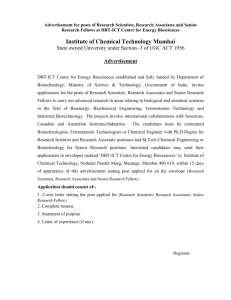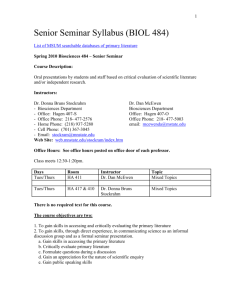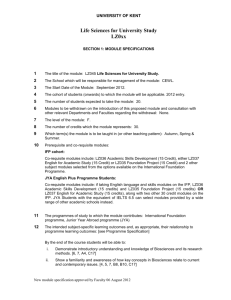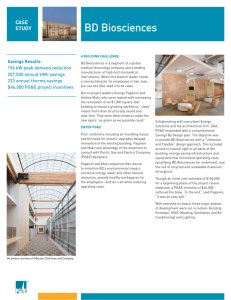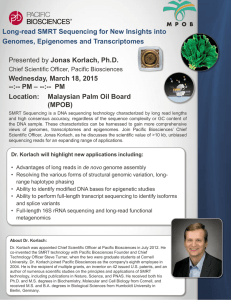BIOL10004-18-2015-gs
advertisement
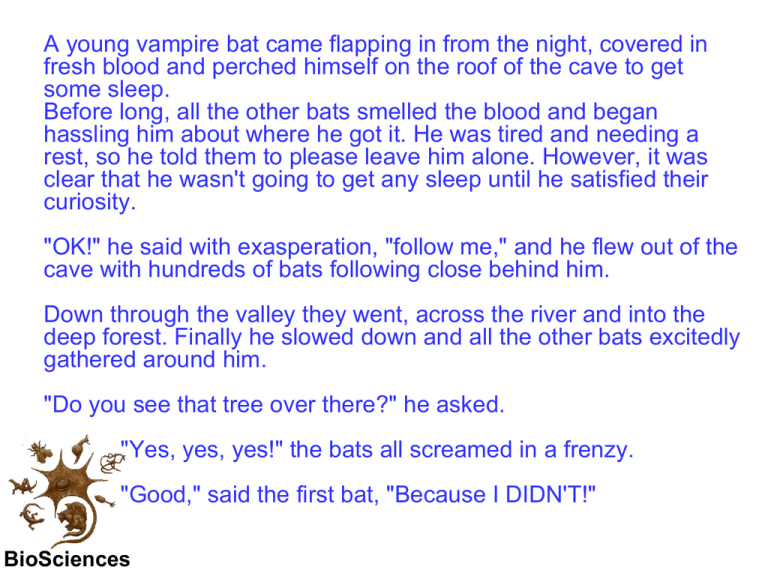
A young vampire bat came flapping in from the night, covered in fresh blood and perched himself on the roof of the cave to get some sleep. Before long, all the other bats smelled the blood and began hassling him about where he got it. He was tired and needing a rest, so he told them to please leave him alone. However, it was clear that he wasn't going to get any sleep until he satisfied their curiosity. "OK!" he said with exasperation, "follow me," and he flew out of the cave with hundreds of bats following close behind him. Down through the valley they went, across the river and into the deep forest. Finally he slowed down and all the other bats excitedly gathered around him. "Do you see that tree over there?" he asked. "Yes, yes, yes!" the bats all screamed in a frenzy. "Good," said the first bat, "Because I DIDN'T!" BioSciences Some Exam Howlers… Three kinds of blood vessels are arteries, vanes and caterpillars. H2O is hot water, and CO2 is cold water. Water is composed of two gins, Oxygin and Hydrogin. Oxygin is pure gin. Hydrogin is gin and water. Blood flows down one leg and up the other. The body consists of three parts- the brainium, the borax and the abominable cavity. The brainium contains the brain, the borax contains the heart and lungs, and the abominable cavity contains the bowels, of which there are five - a, e, i, o, and u. BioSciences Copyright Notice BioSciences Circulation Professor Geoff Shaw School of BioSciences Biosciences-4 g.shaw@zoology.unimelb.edu.au Ref: KLES 5th Ed: Chapter 24: Pp 566-567,572-586; Figures 24.6-8,12,13; Table 7.3 b,c (p159) 4th Ed: Chapter 23: p532, 539 – 551, Fig 23.8-10, 12, 13, Table 7.3c (p149) BioSciences Plus resources on LMS Why have circulation? • distribution – oxygen – CO2 – nutrients – wastes – heat BioSciences Animals with circulatory systems annelid – earthworm mollusc - slug BioSciences insect - butterfly echinoderm – starfish mammal – human Animals without circulatory systems porifera – sponge coelentrate – sea anemone BioSciences platyhelminth (flatworm) – “magic carpet ride” Circulation • • • • Function Types Structure in vertebrates The heart BioSciences Open circulatory system cells bathed directly in blood plasma pump (heart) cell cell cell cell eg crab, beetle cell cell cell cell cell cell cell cell cell cell extracellular fluid ≡ blood body wall Closed circulatory system •blood in vessels •extracellular fluid bathes cells •exchange b/w blood and extracellular fluid •Blood and extracellular fluid are separate. eg. earthworm, vertebrates pump (heart) cell cell cell cell cell cell cell cell cell cell extracellular fluid body wall cell cell Providing oxygen by diffusion only O2 diffusing into animal No O2 reaches here O2 used by cells ≈1 mm BioSciences The theoretical size limit for an animal if only diffusion occurs is a diameter of about 1 mm. • Convection is the bulk movement of fluid • Movement of substances to or from cells by diffusion is usually assisted by convection • Convection is much faster than diffusion Convection: Blood in an artery Blood in a capillary Diffusion Oxygen in water BioSciences To move 1 metre 5 sec 17 min 3 years Convection and Diffusion work together • In closed circulation, the convected blood is separated from the cells by the wall of the blood vessels and by extracellular fluid, as follows: Extracellular fluid Capillary Diffusion shown as BioSciences Blood Cells Note diffusion across capillary wall into extracellular fluid, then into cells. The heart powers convection of the blood • Metabolic energy (muscle) • Energy in the blood – potential energy = pressure – kinetic energy = flow BioSciences Features of hearts Hearts often have: • Several chambers in sequence • first chamber pumps blood into second, etc. • Sequential contraction • One-way flow Valves BioSciences Cardiac contraction cycle • Contraction – systole – expels blood (pronunciation sis-toh-le) • Relaxation – diastole (pronunciation dia-stoh-le) – allows heart to refill with blood • Source of contraction – muscle - myogenic – nerves - neurogenic BioSciences Vertebrate cardiac muscle • specialised type of striated muscle • electrical depolarisation contraction • muscle cells interconnected intercalated discs – strong connections – electrical connections muscle cells • electrical connections between cells allow propagation of contraction • pacemaker activity intercalated discs BioSciences Blood flow in heart during contraction cycle Diastole BioSciences and Systole KLES5 24.6a Blood flow in heart during contraction cycle aorta pulmonary artery Systole BioSciences KLES5 24.6b Conduction of the AP in the mammalian heart Pacemaker Sinoatrial node Atrioventricular node 10 ms. SA node starts AP in atrium 80 ms. Contraction over atrium. AP triggers AV node 0.1 sec delay AV bundle Purkinje fibres BioSciences 170 ms: rapid conduction down AV bundle & Purkinje fibres KLES5 Fig 24.8 190 ms: ventricular contraction propagated from apex expels blood from heart systole From Heart Blood Vessels To Heart vein artery arteriole capillaries BioSciences venule blood vessel structure • arteries – thick walled to cope with pressure; elastin; smooth muscle; endothelium • veins – thinner walled (lower pressure); less muscle/elastin; endothelium; valves Appear white in dissections BioSciences Appear dark in dissections KLES5 fig 24.12 Blood vessel functions • Arteries – high pressure and velocity – elastic reservoir - damps the flow pulse • Arterioles – smooth muscle - to regulate blood flow (and blood pressure) • Capillaries = exchange vessels – low pressure, low velocity – thin wall (<1 µm) - endothelium only – surface area : volume ratio high • SA / Vol = 2prl / pr2l = 2 / r • Veins – low pressure, high-ish velocity – smooth muscle to regulate volume BioSciences KLES fig 24.13 BioSciences “Pull out, Betty, Pull out! … You’ve hit an artery!” BioSciences arteries and disease • arteriosclerosis - hardening of arteries • atherosclerosis - fatty deposits BioSciences T.S. capillary Tight junction diffusion The wall is formed by a rolled endothelial cell capillaryLumen wall transfer (ca 8 µm) - diffusion - pinocytotic (active) transfer - filtration through special fenestrae (windows) filtration Fenestra BioSciences see KLES5 fig 24.15 pinocytosis (Latin: window) in some tissues Capillary • most capillaries don’t leak much – eg blood brain barrier • leaky capillaries in certain sites, eg kidney • active transport in certain sites – eg placenta BioSciences Fish circulation low pressure blood picks up O2 and loses CO2 Gill Body blood loses O2 and picks up CO2 high pressure Heart BioSciences Mammal circulation Body blood loses O2 and picks up CO2 low pressure Lung blood picks up O2 low and loses CO2 pressure R atrium R ventricle BioSciences L atrium high pressure L ventricle Control of heart rate and blood pressure • baroreceptors (pressure) – great veins – aortic arch – carotid body vasomotor centres in brainstem • chemoreceptors (chemicals) Brain – carotid body : O2 – aortic body: CO2 and pH • feed into vasomotor centre in brain stem - regulation of – – – – respiration heart rate; cardiac output blood pressure vascular tone (constriction of blood vessel walls) BioSciences Heart regulation of blood flow • heart rate and strength of beat – affected by emotion, exercise, hormones, temperature, pain, age, and stress • relaxation or constriction of blood vessels – affected by emotion, exercise, hormones, temperature, pain, age, and stress – local effects eg inflammation BioSciences What do I expect you to learn from this lecture? • Why do animals have circulatory systems? • Open and closed circulatory systems; roles of convection and diffusion • Structure and function of the heart – muscle, chambers, valves, pacemaker, conduction, contraction cycle • Differences between arteries, capillaries and veins in structure and function – Why do arteries have elastic walls? Why are capillaries tiny? Why do veins have valves? • How is circulation regulated? BioSciences - central and local control - neural signals to heart and vessels - hormonal and local regulators

